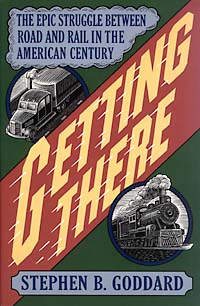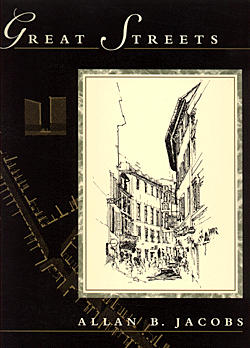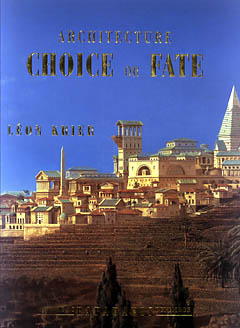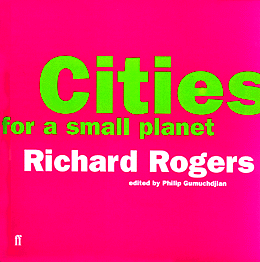 |
||
|
Issue 8 |
|
Fall 1998 |
 Parma, Italy, 1998 Socialization begins at home but soon becomes a community affair. Good public spaces help assure a satisfactory outcome. EventsCarfree Day in BritainThe ETA National Car Free Day will be held in Britain will be on 8 June 1999. The campaign is an effort to convince the government that radical changes to transport policy are not only necessary but would be welcomed by most voters. During the 1998 Car Free Day, 75% of drivers said that they would welcome the banning of cars from city centers.Car Free Cities ConferenceThe next Car Free Cities conference will be held in Athens on 18 June 1999 as the closing event of the EN ROUTE II project (looking at rational use of energy in urban transport). The conference is organized by the European Union. The conference name is a little misleading - it's about reducing urban traffic, not about carfree cities.For more information, e-mail cfc@eurocities.be News from Carfree.comI'm closing down Crawford Systems as of the end of 1998. This will not affect my continuing work towards carfree cities or the publication of this newsletter. My time is largely taken up with writing the book, Carfree Cities, which I intend to publish in 1999.Quotes of the QuarterI couldn't decide between the two best quotes, so I've included both.
Peter Hall, Cities of Tomorrow, p 204.
Richard Risemberg World News Notes & CommentA selection of worldwide current-events involving the urban automobile during the previous season.Please Pass the Fresh AirIn Western Europe, the transport sector (including aviation and shipping) contributes the following share of total air pollution components:
Gasp! Carfree Day in FranceFrance conducted a half-hearted nationwide carfree day this fall. A few token streets were closed in most cities and people were asked not to drive to work. Even though the scale of the project was quite small, the effects were still perceptible - traffic was lighter.The city of La Rochelle held one car-free day last year and since then the use of public transport has since risen by 70 percent, so sometimes even small actions have large effects. Various sources These actions come in the wake of several days last summer when air pollution in Paris has reached crisis levels. Interestingly, about 2/3s of French people believe that city centers should be carfree. Americans Vote Against SprawlThe 1998 mid-term elections in the USA are now seen by many as a clear signal that people have had enough of suburban sprawl. All across the country, measures to limit sprawl were adopted.Sprawl Control: A Political Issue Comes of Age This has been a long time coming, but it looks like it's here. The Third Rush HourFor decades, traffic jams have been a morning and evening routine in cities across the USA. Now, however, a third rush hour is emerging: lunch time. In fact, traffic on the roads is higher at 1400 than at 0800 or 1800. Traffic accidents now run at an even high rate during the lunch period than during normal commute hours."It's Lunchtime... What's the Rush?" I suppose next we'll be hearing about the midnight rush hour. This is all happening because people are trying to cram in errands during their lunch hour for which they have no other time. Driving, driving, driving... there must be a better way. Symposium: "Beyond Oil: Transport & Fuel for the Future"The Chartered Institute of Transport in Australia held a 1998 symposium on the question of what happens when the oil runs out. Some choice nuggets from the press release after the conference:
We have reached a crucial stage in the development of our local, national and international transport services. Our present path is leading us into potentially serious economic, social and environmental problems. New directions are needed for our future transport fuels and vehicles. 'More of the same' in our current transport plans and ways of thinking is no longer tenable. The real cost of transport is going to increase and the decline in the scope and scale of present transport systems is inevitable and will be a major factor in setting the economic agenda for the 21st century.
Press release from My Australian contact, Charlie Richardson, had this to say about the CITIA: Bicycle-Free Street In BeijingIt was recently announced that Xisi Street, a major artery in Beijing, would be closed to bicycles, so cars could get through. The street routinely experienced severe traffic jams."Tide of Traffic Turns Against the Sea of Bicycles" The Sad NumbersThe combined rates of pedestrian and bicycle fatalities were recently tabulated for US cities. Memphis, Nashville, Phoenix, Detroit, and Dallas led the list, with a rate ranging between 16 and 20 fatalities per 100,000 population. Boston, Indianapolis, New York, Seattle, San Jose, and Milwaukee were the best, with between 4 and 6.5 fatalities per 100,00."Look Both Ways" Someone should investigate this. I suspect that local attitudes have a strong effect on the rates. Most of the cities with very high rates are in the southern states, excepting only Detroit, where the car has always been sacred. If you live in Memphis, your chances of dying as a pedestrian or cyclist approach 1 in 50. New US Law Benefits Transit RidersChanges in the federal tax law will permit transit riders in the USA to receive tax-free transit passes from their employers. Companies will even be permitted to give tax-free cash bonuses for not using free parking lots provided by employers. See section 910 of the Surface Transportation Revenue Act of 1998 for details.Environmental Defense Fund EDF helped get this legislation passed. Good job, folks. Stop Talking and Do SomethingThe recent Buenos Aires summit on global climate change didn't accomplish much. Following on the heels of the Kyoto Accords, the meeting was supposed to thrash out some of the difficult issues standing in the way of achieving real reductions in greenhouse gas emissions. The Kyoto agreements require the developed nations to reduce greenhouse gas emissions in 2010 by an average of 5.2% compared to 1990. Dutch emissions, scheduled to decline by 6%, are now actually 7% above the 1990 level and rising."Klimaattop Buenos Aires afgesloten met 'vaag' plan" The Dutch talk a good game on this and a number of other environmental points, but when it actually comes to doing something that might have unpopular consequences, nothing is likely to happen. My skepticism about Dutch policy arises partly from the handling of environmental issues affecting Amsterdam's Schiphol Airport, one of Europe's five biggest airports. Firm agreements were reached just three years ago on permanent traffic limitations for the airport, which was then operating well below the permitted levels. Traffic grew much more rapidly than was expected, and the latest government talk is that traffic at the airport could be permitted to rise to nearly double the agreed levels. The limitations were acceptable as long as they were not going to have any consequences. It looks like the same situation with greenhouse gases. Gas Costs How Much?The International Center for Technology Assessment reports that gasoline costs the US economy between $5.60 to $15.14 per gallon. (The pump price in the USA is now around $1.00/gallon.) The externalized costs are tailpipe emissions, industry tax breaks, military protection of oil supplies, and various other costs.More than 40 externalities were examined, and it was found that the US spends between $558.7 billion and $1.69 trillion to support the production of gasoline. Environmental, health and social costs are the hardest to quantify, the report stated. These costs, however, appear to represent "the largest portion of the externalized price Americans pay for their gasoline reliance." "The Real Price of Gasoline: Report No. 3 Roads Cost How Much?A 1.5 mile section of the Cypress Freeway in Oakland, California, collapsed in the 1989 earthquake with heavy loss of life. The replacement road has just been finished. It cost over a billion dollars, making this the most expensive road (per mile) ever built.From a posting by Michael Ayers to the You Can Do Anything on a BikeA funeral was recently conducted in Groningen by bicycle. The coffin was carried on a special bicycle trailer pulled by the deceased's brother. Mourners followed by bicycle. The coffin was made by the decedent herself, of unpainted birch lined with reeds. "A funeral has rarely been so environmentally friendly," according to NRC Handelsblad. It was a dignified occasion that tread but lightly on the Earth."Uitvaart op de fiets," NRC Handelsblad, 2 October 1998 We have proposed the use of cavalcades for funerals and other formal events in the carfree city. Bicycles are an excellent alternative. Letters to the EditorDear Editor,I just heard that new cars are about to get "even safer." But do these new crash tests involve crashing cars into pedestrians and cyclists? If not, then "safer cars" are likely to become even more dangerous for vulnerable road users. How? Well, as drivers are made to feel ever more cocooned inside their impregnable vehicles, so they will take greater risks. For example, ABS brakes and racing suspension encourage drivers to take corners faster. Meanwhile, the airbags and side-impact bars will encourage them to think that even if they do crash, it won't hurt. But what about me on my bike, and my granny walking down the road to the shops? When will the car makers and legislators consider our safety? If John Prescott wants to double the number of cycle journeys by 2002 then he will have to address this question - road danger is the greatest deterrent to cycling. Real safety for all road users can only be achieved by slowing cars down. This means 20mph limits in all residential areas, outside schools, etc. 20mph must become the urban norm. It also means fitting variable speed limiters to all cars, since 72% of drivers do not even respect the current 30mph urban limit.
Yours sincerely, Book ReviewsWe haven't carried any book reviews lately, and there was a stack of books awaiting review, so I decided to work through all of them in this issue, in somewhat more telegraphic style than usual.Getting There This is an impressive work that documents the rise of the railroad in American life, increasing public outrage over railroad depredations, and the enthusiastic public acceptance of motorized passenger and freight transport. The meteoric rise and fall of the interurban railways and the demise of trolley systems at the hands of highway interests are also important themes. Mr. Goddard is a lawyer, journalist, and congressional aide with broad experience in transportation issues. He has written a carefully documented work with a strong emphasis on how politics, regulation, and public relations brought America to its current condition of gridlock on the highways and poor public transportation alternatives. The book has a strong legislative slant, and the establishment of the Interstate Commerce Commission to regulate railroads (and much later, trucks and buses) is treated in detail. This book is highly recommended for anyone with an interest in transportation issues, especially as related to the US. (Other nations would do well to study these painful lessons.) Stephen B. Goddard Great Streets This is one of those books that is a delight to receive. It's a large-format book, beautifully illustrated with hundreds of pen-and-ink drawings. There are plan views, perspective drawings, and cross-sections (which are also dimensioned). It reviews great streets around the world, from large European cities to the best American suburbs (OK, yes, there are a few nice suburbs). One section is entitled, "Once Great Streets." The saddest of these is Market Street in San Francisco. There is a long ode to the street as it was in its heyday in the 1930s. Today it is a victim of wretched skyscrapers and lifeless forecourts. For anyone interested in the details of what makes some streets work and others not, this is an indispensable reference work, a wealth of information that would be difficult to obtain from other sources. Allan B. Jacobs Architecture: Choice or Fate This beautifully produced large-format book was written by Léon Krier, one of the few modern architects who is not scared to make use of our vast architectural heritage. He understands what makes outdoor spaces work. Krier has a sharp sense of humor - there is a devastating drawing entitled "Conservative versus Creative Restauration" [sic] which shows a "Derelict Modernist Masterpiece" (obviously from the hand of Le Corbusier), followed by a "Conservative Restauration (Nostalgic)" showing the building restored to its original (dreadful) form, followed by a "Creative (forward looking) Restauration" showing the building restored with classical elements. If you're a fan of Modernism, you will hate this book - it is about as friendly towards Modernism as Tom Wolfe's stinging From Bauhaus to Our House. The author's prejudices are given in some of the chapter titles. (To be sure, I share most of the author's prejudices, which I believe actually have a sound foundation in the centuries of human experience with making places that work for people.) Some examples: "Critique of A Modernist Ideology" and "The Modernity of Traditional Architecture." The book is illustrated with drawings of many of Krier's commissions, including perhaps his most famous, Prince Charles' new town, Poundbury. Léon Krier Especially recommended for anyone in need of a laugh, this book is one of the few contemporary books on architecture that will satisfy those with an abiding abhorrence of Modernism. Cities of Tomorrow I haven't got much to say about this book beyond the fact that it is the definitive history of modern urban planning. Although it only claims to cover the 20th century, it in fact dips back into the late 19th century. If you want to know how we got to where we are, you have to read this book. It's well written and profusely illustrated. Peter Hall Cities for a Small Planet Rogers is certainly no classicist in his architecture, although one gets the idea that he at least appreciates a good classical building. He does clearly understand the principles of good urban design and is well aware of the ravages of cars and the need for good pedestrian spaces. There is one very telling quote:
I was myself impressed by its civility as recently as 1965, but when I last visited in 1987, I was very depressed by the changes I saw, particularly the traffic. Rogers' architectural style is daring, sometimes too daring. Some of the buildings work out quite well, even though they are clearly modern (but clearly not Modernist). Other projects, such as the law courts for Bordeaux, look like nothing so much as a chemistry experiment gone wrong. The final part of the book delves into the quandary we face today: ecological problems, swelling populations, and the need to build decent cities that are less of a burden on the environment and a better place to spend time. The book closes with a manifesto for the sustainable city, which is:
The book is nicely designed, and was, in fact, the inspiration for the design of my own forthcoming book, Carfree Cities, which will be exactly the same dimensions and have the same basic layout. The book is surprisingly inexpensive but nicely printed and bound. Now, about that cover.... Richard Rogers Subscribe to Carfree TimesCarfree Times is published at Carfree.com at the end of each season. To receive e-mail notification of new issues, please send e-mail with the word "Subscribe" in the subject line. We do not share our mailing list. Contact Information |
| J.H. Crawford | |
| Tel. | +31 20 638 5115 |
| Send e-mail | |
| URL | http://www.carfree.com/ |
Carfree Times Home
Carfree Times Back Issues (1-12)
Continue on to Car-Free Times Issue 7
About the book: Carfree Cities
Return to Carfree.com
Copyright ©1998 J.Crawford